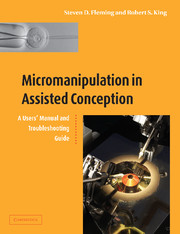27 results
Chapter 12 - Micromanipulation, Micro-Injection Microscopes and Systems for ICSI
-
-
- Book:
- Manual of Intracytoplasmic Sperm Injection in Human Assisted Reproduction
- Published online:
- 02 December 2021
- Print publication:
- 25 November 2021, pp 114-128
-
- Chapter
- Export citation
Test stewardship, frequency and fidelity: Impact on reported hospital-onset Clostridioides difficile
-
- Journal:
- Infection Control & Hospital Epidemiology / Volume 40 / Issue 6 / June 2019
- Published online by Cambridge University Press:
- 22 April 2019, pp. 710-712
- Print publication:
- June 2019
-
- Article
- Export citation
Glossary
-
- Book:
- Micromanipulation in Assisted Conception
- Published online:
- 10 September 2009
- Print publication:
- 06 November 2003, pp xii-xvi
-
- Chapter
- Export citation
11 - Transgenesis and the generation of knock-out mice
-
- Book:
- Micromanipulation in Assisted Conception
- Published online:
- 10 September 2009
- Print publication:
- 06 November 2003, pp 189-212
-
- Chapter
- Export citation
7 - Preparation of gametes for micromanipulation
-
- Book:
- Micromanipulation in Assisted Conception
- Published online:
- 10 September 2009
- Print publication:
- 06 November 2003, pp 101-118
-
- Chapter
- Export citation
Index
-
- Book:
- Micromanipulation in Assisted Conception
- Published online:
- 10 September 2009
- Print publication:
- 06 November 2003, pp 241-246
-
- Chapter
- Export citation
4 - Eppendorf micromanipulation workstation systems
-
- Book:
- Micromanipulation in Assisted Conception
- Published online:
- 10 September 2009
- Print publication:
- 06 November 2003, pp 61-78
-
- Chapter
- Export citation

Micromanipulation in Assisted Conception
-
- Published online:
- 10 September 2009
- Print publication:
- 06 November 2003
List of abbreviations
-
- Book:
- Micromanipulation in Assisted Conception
- Published online:
- 10 September 2009
- Print publication:
- 06 November 2003, pp xvii-xx
-
- Chapter
- Export citation
Frontmatter
-
- Book:
- Micromanipulation in Assisted Conception
- Published online:
- 10 September 2009
- Print publication:
- 06 November 2003, pp i-iv
-
- Chapter
- Export citation
6 - Instrument selection
-
- Book:
- Micromanipulation in Assisted Conception
- Published online:
- 10 September 2009
- Print publication:
- 06 November 2003, pp 91-100
-
- Chapter
- Export citation
2 - Media and other consumables for micromanipulation
-
- Book:
- Micromanipulation in Assisted Conception
- Published online:
- 10 September 2009
- Print publication:
- 06 November 2003, pp 15-28
-
- Chapter
- Export citation
1 - Micromanipulation in human assisted conception: an overview
-
- Book:
- Micromanipulation in Assisted Conception
- Published online:
- 10 September 2009
- Print publication:
- 06 November 2003, pp 1-14
-
- Chapter
- Export citation
Acknowledgements
-
- Book:
- Micromanipulation in Assisted Conception
- Published online:
- 10 September 2009
- Print publication:
- 06 November 2003, pp xi-xi
-
- Chapter
- Export citation
12 - New and advanced techniques
-
- Book:
- Micromanipulation in Assisted Conception
- Published online:
- 10 September 2009
- Print publication:
- 06 November 2003, pp 213-220
-
- Chapter
- Export citation
5 - Research Instruments micromanipulation workstation systems
-
- Book:
- Micromanipulation in Assisted Conception
- Published online:
- 10 September 2009
- Print publication:
- 06 November 2003, pp 79-90
-
- Chapter
- Export citation
References
-
- Book:
- Micromanipulation in Assisted Conception
- Published online:
- 10 September 2009
- Print publication:
- 06 November 2003, pp 229-240
-
- Chapter
- Export citation
Preface
-
- Book:
- Micromanipulation in Assisted Conception
- Published online:
- 10 September 2009
- Print publication:
- 06 November 2003, pp ix-x
-
- Chapter
- Export citation
9 - Zona manipulation and embryo biopsy
-
- Book:
- Micromanipulation in Assisted Conception
- Published online:
- 10 September 2009
- Print publication:
- 06 November 2003, pp 153-166
-
- Chapter
- Export citation
Contents
-
- Book:
- Micromanipulation in Assisted Conception
- Published online:
- 10 September 2009
- Print publication:
- 06 November 2003, pp v-vi
-
- Chapter
- Export citation



